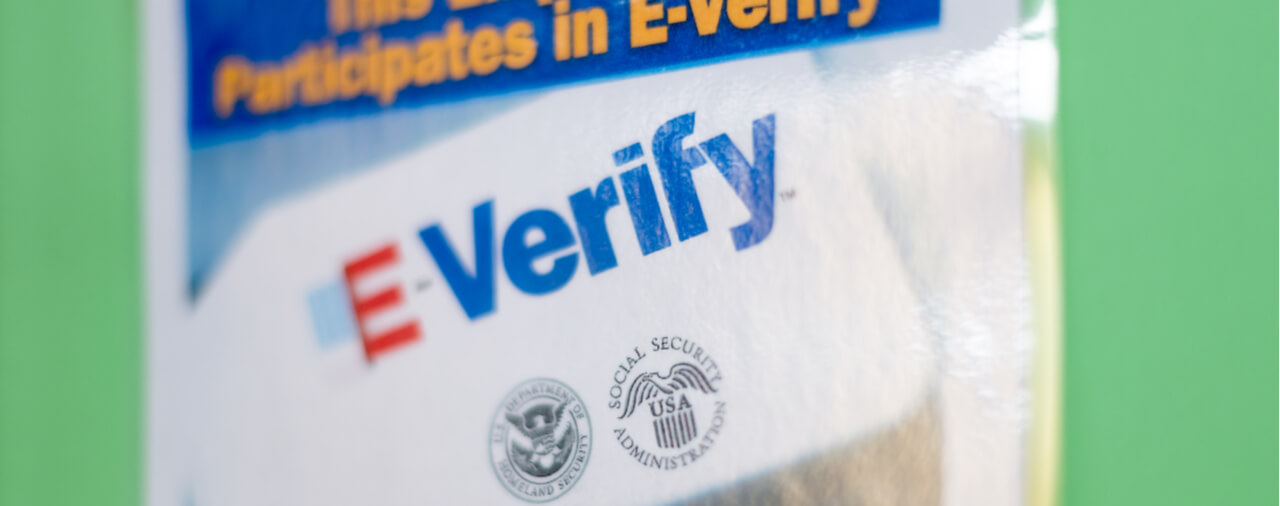The Many Problems of E-Verify
I recently came across a terrific paper courtesy of the Cato Institute that I would like to share with you, “Checking E-Verify: The Costs and Consequences of a National Worker Screening Mandate,” by Alex Nowrasteh and Jim Harper [link]. The article uses ample facts, figures, and other evidence from seeing E-Verify in practice to argue a point with which I agree wholeheartedly: E-Verify is a terrible system. I encourage anyone who is interested in immigration law and policy to follow the link and download the free article to read in full, but I would like to share some of the key points and my thoughts on them with you here.
The goal of E-Verify is to cut down on the number of aliens working in the United States without employment authorization. In order to accomplish this goal, E-Verify must make it significantly more difficult for unauthorized workers to find employment in the United States, and thus take away the incentive to cross into the United States or stay in the United States without authorization. To be certain, these are important goals in order to maintain the integrity of the immigration system. However, sounding like a good idea does not make something a good idea, and E-Verify has been shown not to accomplish the goals set out for it.
Before E-Verify, the Immigration Reform and Control Act (IRCA) implemented in 1986 the Form I-9, Employment Eligibility Verification. Alien employees are required to provide an employer with documentation such that the employer may complete the I-9, and then the employer must assess the documentation and make a determination if the employee is, in fact, work-authorized. However, Nowrasteh and Harper note that both the I-9 system and the subsequent E-Verify system “conscripted employers into immigration law enforcement.”1 While employers have a legal obligation not to employ unauthorized workers, it is important to remember that very few employers, well-intentioned or otherwise, are immigration law experts or qualified to assess the veracity of a prospective employee's documentation. Nowrasteh and Harper note the I-9's system's inadequacy by citing that in that in the first seven years of the I-9 requirement, “roughly half of all the unauthorized immigrants hired in the United States were hired by employers who complied with I-9 requirements.”2 Furthermore, they add that many employers either ignored the I-9 requirements entirely and simply paid unauthorized employees at a slightly lower wage to offset the potential cost of fines, or circumvented the requirements by using subcontracted labor wherein the subcontractor assumed any liability for employing unauthorized workers.3
E-Verify was created as part of the Illegal Immigration Reform and Immigrant Responsibility Act of 1996 to improve on the I-9 system. Since its inception, four states have mandated its use statewide for certain periods and many other states have either mandated it in limited areas or made its use voluntary. Because of this, we now have concrete evidence with which to assess E-Verify's actual effectiveness.
After an employer enrolls in E-Verify, the employer must run a new employee's government identification information, notably including the social security number (SSN), through E-Verify. If E-Verify finds that the information is valid and not already in use, the employee will be allowed to start work. However, if E-Verify finds a discrepancy, it will return a tentative nonconfirmation (TNC). The employer then has a legal obligation to inform the employee, who will have ten days to begin an appeal. However, Nowrasteh and Harper note that this is onerous because it is very difficult for employees to access their information to determine the basis of the discrepancy. Employees often must file Privacy Act requests with both the Department of Homeland Security and the Social Security Administration to try to find where the issue lies. Nowrasteh and Harper note, that in 2009, the average wait time for a Privacy Act request was a stark 104 days.4
Furthermore, Nowrasteh and Harper cite an independent audit of E-Verify in 2012 that indicated E-Verify had a 0.3% total false positive rate in 2010, with the rate being 0.2% for U.S. citizens and 2% for immigrants with lawful status.5 While those numbers may sound low, the authors note that if E-Verify was mandated nationally and maintained the same false TNC rates, 1.2 million workers would have been issued false TNCs, with some taking many months to resolve.6 Furthermore, there is little reason to assume that these numbers would improve were E-Verify to be implemented on a much larger scale.
Nowrasteh and Harper also show that E-Verify's only problem is not false-positives. In fact, they note that since E-Verify only makes a comparison between a name and SSN entered in to its database, it is extremely susceptible to fraud and identity theft. For example, they note that E-Verify often cannot identify when an employee is using an SSN that belonged to a person who is long-since dead. They cite a recent audit of E-Verify that revealed that 54% of unauthorized workers who were run through E-Verify were cleared.7
The four states in which E-Verify has been mandated-Alabama , Arizona, Mississippi, and South Carolina-are noted for the emphasis that their state governments place on immigration enforcement. These four states are noted for the emphasis that voters and their government put on immigration enforcement. Nevertheless, the states have been generally ineffective in actually making employers comply with the E-Verify mandates. Nowrasteh and Harper show that in fifteen combined years among the four states (from 2008-13) when they had E-Verify mandated, only South Carolina in 2011 and 2012 exceeded 59% recorded compliance with the mandate, and even South Carolina dropped to 54.9% in 2013.8 They add that these numbers are likely vast overestimates, since they do not include when employers hired unauthorized workers with no paper trails.9
Nowrasteh and Harper cite that prior to E-Verify being mandated in Arizona in 2008, a Mexican immigrant could expect to make 253% more on average working undocumented in the United States than staying in Mexico. In 2012, that number was reduced to 240%, hardly denting the incentive for working in the United States illegally.10 Across all four states, the unauthorized employment rate among men declined by 3% and women by 7% while E-Verify was mandated, but the wages for unauthorized employment increased by 3.5%.11 In effect, Nowrasteh and Harper argue that if the supply of unauthorized workers is slightly decreased, the demand for unauthorized workers slightly increases, thus having at best a negligible effect on the incentive to work in the United States without authorization.
These are just some of the key points from this well-reasoned article, and I certainly encourage you to read in its entirety. Without knowing how it works, E-Verify may sound appealing. However, knowing how E-Verify works in practice and studying its ineffectiveness where it has been used most, it is impossible for me to see how “more E-Verify” is the solution to any immigration problem. I certainly hope that our elected officials carefully study how E-Verify has failed instead of rushing to make it part of a large immigration reform package.
Fortunately, we here at Grinberg and Segal are acutely aware of all of the trials that may into play come with E-Verify and the I-9 process, so if you have any immigration issues related to those issues or otherwise, please do not hesitate to schedule a consultation so that we may evaluate your problem and provide you with expert counsel.
______________________
- Nowrasteh, Alex and Jim Harper. “Checking E-Verify: The Costs and Consequences of a National Worker Screening Mandate.” Cato Institute Policy Analysis, no. 775 (July 7, 2015) 2
- Id., citing Douglas S. Massey, Jorge Durand, and Nolan J.Malone, Beyond Smoke and Mirrors: Mexican Immigration in an Era of Economic Integration (New York: Russell Sage Foundation, 2002), p. 119.
- Nowrasteh and Harper 3
- Id. at 4, citing Government Accountability Office, “Employment Verification: Federal Agencies Have Taken Steps to Improve E-Verify, but Significant Challenges Remain,” GAO-11-146, December 2010, p. 34.
- Nowrasteh and Harper 15, citing Westat Research Corporation, “Evaluation of the Accuracy of E-Verify Findings,” July, 2012, pp. XV, 24-25, 51-54.
- Id.
- Nowrasteh and Harper 7, citing Westat Research Corporation, “Findings of the E-Verify® Program Evaluation,” December 2009, p. 44.
- Nowrasteh and Harper 8, citing John Stark, “E-Verify and Agriculture-Arizona Perspective,” Bellingham Herald Politics Blog, September 30, 2011, http://blogs.bellinghamherald.com/politics/politics/e-verify-and-agriculture-arizona-perspective/.
- Nowrasteh and Harper 9
- Id. at 10, citing Annie Gasparro, “Chipotle Faces New Pressure from Probe of Workers' Immigration Status,” Wall Street Journal, May 21, 2012, http://professional.wsj.com/article/BT-CO-20120521-712511.html?mgreno64-wsj; Maricopa County Sheriff's Office, “Sheriff's Deputies Continue Search for Pei Wei Restaurant Employees Using False Identification,” news release, March 8, 2011; and Maricopa County Sheriff's Office, “Popular Asian Diner Chain Subject of Identification Theft Operation by Sheriff's Deputies,” press release, March 4, 2011.
- Nowrasteh and Harper 10, citing Pia M. Orrenius and Madeline Zavodny, “How Do E-Verify Mandates Affect Unauthorized Immigrant Workers?” Dallas Fed Working Paper no. 1403 (2014), pp. 13-14, 24.
Resources and materials:
Nowrasteh, Alex and Jim Harper. “Checking E-Verify: The Costs and Consequences of a National Worker Screening Mandate.” Cato Institute Policy Analysis, no. 775 (July 7, 2015): Accessed August 14, 2015. http://www.cato.org/publications/policy-analysis/checking-e-verify-costs-consequences-national-worker-screening-mandate

- Alexander J. Segal's blog
- Log in to post comments
